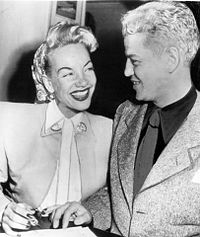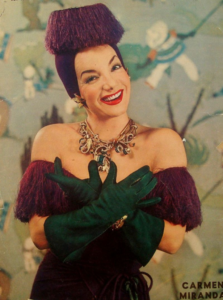 On this day in 1955, The Brazilian Bombshell, samba singer, dancer, actress Carmen Miranda died from a heart attack at her home in Beverly Hills. She was 46. Born Maria do Carmo Miranda da Cunha on 9 February 1909 in in Várzea da Ovelha e Aliviada, a village in the northern Portuguese municipality of Marco de Canaveses. Perhaps best known for her signature fruit hat outfit she wore in her American films. As a young woman, she designed hats in a boutique before making her first recordings with composer Josué de Barros in 1929. Miranda’s 1930 recording of “Taí (Pra Você Gostar de Mim)”, written by Joubert de Carvalho, catapulted her to stardom in Brazil as the foremost interpreter of samba.
On this day in 1955, The Brazilian Bombshell, samba singer, dancer, actress Carmen Miranda died from a heart attack at her home in Beverly Hills. She was 46. Born Maria do Carmo Miranda da Cunha on 9 February 1909 in in Várzea da Ovelha e Aliviada, a village in the northern Portuguese municipality of Marco de Canaveses. Perhaps best known for her signature fruit hat outfit she wore in her American films. As a young woman, she designed hats in a boutique before making her first recordings with composer Josué de Barros in 1929. Miranda’s 1930 recording of “Taí (Pra Você Gostar de Mim)”, written by Joubert de Carvalho, catapulted her to stardom in Brazil as the foremost interpreter of samba.
During the 1930s Miranda performed on Brazilian radio and appeared in five Brazilian chanchadas, films celebrating Brazilian music, dance, and the country’s carnival culture. Hello, Hello Brazil! and Hello, Hello, Carnival! embodied the spirit of these early Miranda films. The 1939 musical Banana da Terra (directed by Ruy Costa) gave the world her “Baiana” image, inspired by African-Brazilians from the northeastern state of Bahia.
In 1939, Broadway producer Lee Shubert offered Miranda an eight-week contract to perform in The Streets of Paris after seeing her at Cassino da Urca in Rio de Janeiro. The following year she made her first Hollywood film, Down Argentine Way with Don Ameche and Betty Grable, and her exotic clothing and Lusophone accent became her trademark. That year, she was voted the third-most-popular personality in the United States, and she and her group, Bando da Lua, were invited to sing and dance for President Franklin D. Roosevelt. In 1943, Miranda starred in Busby Berkeley’s The Gang’s All Here, which was noted for its musical numbers with the fruit hats that became her trademark. By 1945, she was the highest-paid woman in the United States.
Miranda made 14 Hollywood films between 1940 and 1953. Miranda came to resent the stereotypical “Brazilian Bombshell” image she had cultivated, and attempted to free herself of it. She focused on nightclub appearances and became a fixture on television variety shows. Despite being stereotyped, Miranda’s performances popularized Brazilian music and increased public awareness of Latin culture. In 1941 she was the first Latin American star to be invited to leave her hand and footprints in the courtyard of Grauman’s Chinese Theatre, and was the first South American honored with a star on the Hollywood Walk of Fame. Miranda is considered the precursor of Brazil’s 1960s Tropicalismo cultural movement.
Desiring creative freedom, Miranda decided to produce her own film in 1947 and played opposite Groucho Marx in Copacabana. The film’s budget was divided into about ten investors’ shares. A Texan investor who owned one of the shares sent his brother, David Sebastian (23 November 1907 – 11 September 1990), to keep an eye on Miranda and his interests on the set. Sebastian befriended her, and they began dating.
Miranda and Sebastian married on 17 March 1947 at the Church of the Good Shepherd in Beverly Hills, with Patrick J. Concannon officiating. In 1948 Miranda became pregnant, but miscarried after a show. Although the marriage was brief, Miranda (who was Catholic) did not want a divorce. Her sister, Aurora, said in the documentary Bananas is My Business: “He married her for selfish reasons; she got very sick after she married and lived with a lot of depression”. The couple announced their separation in September 1949, but reconciled several months later.
Miranda was discreet, and little is known about her private life. Before she left for the US, she had relationships with Mario Cunha, Carlos da Rocha Faria (son of a traditional family in Rio de Janeiro) and Aloísio de Oliveira, a member of the Bando da Lua. In the US, Miranda maintained relationships with John Payne, Arturo de Córdova, Dana Andrews, Harold Young, John Wayne, Donald Buka and Carlos Niemeyer.
The Final Footprint
In accordance with her wishes, Miranda’s body was flown back to Rio de Janeiro. The Brazilian government declared a period of national mourning. About 60,000 people attended her memorial service at the Rio town hall, and more than half a million Brazilians escorted her funeral cortège to the cemetery.
Miranda is buried in São João Batista Cemetery in Rio de Janeiro. In 1956 her belongings were donated by her husband and family to the Carmen Miranda Museum, which opened in Rio on 5 August 1976. For her contributions to the entertainment industry, Miranda has a star on the Hollywood Walk of Fame at the south side of the 6262 block of Hollywood Boulevard. In 1995 she was the subject of the documentary Carmen Miranda: Bananas is My Business.
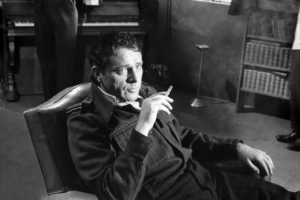 On this day in 1984, actor, 7x Academy Award nominee, Richard Burton died at age 58 from a brain haemorrhage at his home in Céligny, Switzerland. Born Richard Walter Jenkins in the village of Pontrhydyfen, Neath Port Talbot, Wales on 10 November 1925. Although never trained as an actor, Burton was at one time the highest-paid actor in Hollywood. Burton remains closely associated in the public consciousness with his second wife, actress Elizabeth Taylor. The couple’s turbulent relationship was rarely out of the news. Burton was married five times; Welsh actress/producer Sybil Williams (1949 – 1963 divorce), Taylor twice, consecutively from 15 March 1964 to 26 June 1974 and from 10 October 1975 to 29 July 1976, Susan Hunt (1976 – 1982 divorce) and Sally Hay (1983 – 1984 his death). Burton reportedly once said about himself, “I rather like my reputation, actually, that of a spoiled genius from the Welsh gutter, a drunk, a womanizer; it’s rather an attractive image.”
On this day in 1984, actor, 7x Academy Award nominee, Richard Burton died at age 58 from a brain haemorrhage at his home in Céligny, Switzerland. Born Richard Walter Jenkins in the village of Pontrhydyfen, Neath Port Talbot, Wales on 10 November 1925. Although never trained as an actor, Burton was at one time the highest-paid actor in Hollywood. Burton remains closely associated in the public consciousness with his second wife, actress Elizabeth Taylor. The couple’s turbulent relationship was rarely out of the news. Burton was married five times; Welsh actress/producer Sybil Williams (1949 – 1963 divorce), Taylor twice, consecutively from 15 March 1964 to 26 June 1974 and from 10 October 1975 to 29 July 1976, Susan Hunt (1976 – 1982 divorce) and Sally Hay (1983 – 1984 his death). Burton reportedly once said about himself, “I rather like my reputation, actually, that of a spoiled genius from the Welsh gutter, a drunk, a womanizer; it’s rather an attractive image.”
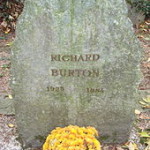 The Final Footprint – Burton is interred in Vieux Cemetery, Celigny, Switzerland, in a red suit, a tribute to his Welsh roots, and with a copy of Dylan Thomas’ poems. He and Taylor had discussed being buried together. His widow Sally purchased the plot next to Burton’s to ensure she would be buried next to him.
The Final Footprint – Burton is interred in Vieux Cemetery, Celigny, Switzerland, in a red suit, a tribute to his Welsh roots, and with a copy of Dylan Thomas’ poems. He and Taylor had discussed being buried together. His widow Sally purchased the plot next to Burton’s to ensure she would be buried next to him.
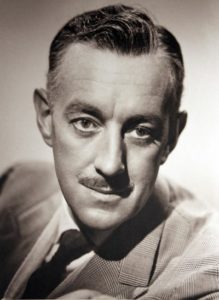 On this day in 2000 Royal Naval Reserve veteran, actor Alec Guinness died from liver cancer, at Midhurst in West Sussex at the age of 86. Born Alec Guinness de Cuffe on 2 April 1914 in Maida Vale, London. After an early career on the stage, Guinness was featured in several of the Ealing Comedies, including The Ladykillers and Kind Hearts and Coronets in which he played nine different characters. He is also known for his six collaborations with David Lean: Herbert Pocket in Great Expectations (1946), Fagin in Oliver Twist (1948), Col. Nicholson in The Bridge on the River Kwai (1957, for which he won the Academy Award for Best Actor), Prince Faisal in Lawrence of Arabia (1962), General Yevgraf Zhivago in Doctor Zhivago(1965), and Professor Godbole in A Passage to India (1984). He is also known for his portrayal of Obi-Wan Kenobi in George Lucas’s original Star Wars trilogy, receiving a nomination for the Academy Award for Best Supporting Actor.
On this day in 2000 Royal Naval Reserve veteran, actor Alec Guinness died from liver cancer, at Midhurst in West Sussex at the age of 86. Born Alec Guinness de Cuffe on 2 April 1914 in Maida Vale, London. After an early career on the stage, Guinness was featured in several of the Ealing Comedies, including The Ladykillers and Kind Hearts and Coronets in which he played nine different characters. He is also known for his six collaborations with David Lean: Herbert Pocket in Great Expectations (1946), Fagin in Oliver Twist (1948), Col. Nicholson in The Bridge on the River Kwai (1957, for which he won the Academy Award for Best Actor), Prince Faisal in Lawrence of Arabia (1962), General Yevgraf Zhivago in Doctor Zhivago(1965), and Professor Godbole in A Passage to India (1984). He is also known for his portrayal of Obi-Wan Kenobi in George Lucas’s original Star Wars trilogy, receiving a nomination for the Academy Award for Best Supporting Actor.
Guinness married the artist, playwright, and actress Merula Sylvia Salaman (1914–2000) in 1938. The family lived at Steep Marsh in Hampshire.
The Final Footprint
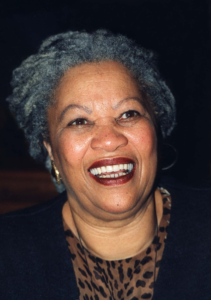 On this day in 2019, novelist, essayist, book editor, and college professor Toni Morrison died at Montefiore Medical Center in The Bronx from complications of pneumonia at the age of 88. Born Chloe Ardelia Wofford on February 18, 1931 in Lorain, Ohio. Her first novel, The Bluest Eye, was published in 1970. The critically acclaimed Song of Solomon (1977) brought her national attention and won the National Book Critics Circle Award. In 1988, Morrison won the Pulitzer Prize for Beloved (1987). She gained worldwide recognition when she was awarded the Nobel Prize in Literature in 1993.
On this day in 2019, novelist, essayist, book editor, and college professor Toni Morrison died at Montefiore Medical Center in The Bronx from complications of pneumonia at the age of 88. Born Chloe Ardelia Wofford on February 18, 1931 in Lorain, Ohio. Her first novel, The Bluest Eye, was published in 1970. The critically acclaimed Song of Solomon (1977) brought her national attention and won the National Book Critics Circle Award. In 1988, Morrison won the Pulitzer Prize for Beloved (1987). She gained worldwide recognition when she was awarded the Nobel Prize in Literature in 1993.
Morrison graduated from Howard University in 1953 with a B.A. in English. In 1955, she earned a master’s in American Literature from Cornell University. In 1957 she returned to Howard University, was married, and had two children before divorcing in 1964. In the late 1960s, she became the first black female editor in fiction at Random House in New York City.
In 1996, the National Endowment for the Humanities selected her for the Jefferson Lecture, the U.S. federal government’s highest honor for achievement in the humanities. Also that year, she was honored with the National Book Foundation’s Medal of Distinguished Contribution to American Letters. On May 29, 2012, President Barack Obama presented Morrison with the Presidential Medal of Freedom. In 2016, she received the PEN/Saul Bellow Award for Achievement in American Fiction.
The Final Footprint
A memorial tribute was held for Morrison on November 21, 2019, at the Cathedral of St. John the Divine in the Morningside Heights neighborhood of Manhattan in New York City. At this gathering she was eulogized by, among others, Oprah Winfrey, Angela Davis, Michael Ondaatje, David Remnick, Fran Lebowitz, and Edwidge Danticat. The jazz saxophonist David Murray performed a musical tribute.
Have you planned yours yet?
Follow TFF on twitter @RIPTFF

